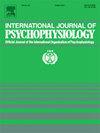When alertness fades: Drowsiness-induced visual dominance and oscillatory recalibration in audiovisual integration
IF 2.5
3区 心理学
Q3 NEUROSCIENCES
引用次数: 0
Abstract
Multisensory integration allows the brain to align inputs from different sensory modalities, enhancing perception and behavior. However, transitioning into drowsiness, a state marked by decreased attentional control and altered cortical dynamics, offers a unique opportunity to examine adaptations in these multisensory processes. In this study, we investigated how drowsiness influences reaction times (RTs) and neural oscillations during audiovisual multisensory integration. Participants performed a task where auditory and visual stimuli were presented either in a coordinated manner or with temporal misalignment (visual-first or auditory-first uncoordinated conditions).
Behavioral results showed that drowsiness slowed RTs overall but revealed a clear sensory dominance effect: visual-first uncoordination facilitated RTs compared to auditory-first uncoordination, reflecting vision's dominant role in recalibrating sensory conflicts. In contrast, RTs in coordinated conditions remained stable across alert and drowsy states, suggesting that multisensory redundancy compensates for reduced cortical integration during drowsiness.
At the neural level, distinct patterns of oscillatory activity emerged. Alpha oscillations supported attentional realignment and temporal alignment in visual-first conditions, while Gamma oscillations were recruited during auditory-first uncoordination, reflecting heightened sensory-specific processing demands. These effects were state-dependent, becoming more pronounced during drowsiness.
Our findings demonstrate that drowsiness fundamentally reshapes multisensory integration by amplifying sensory dominance mechanisms, particularly vision. Compensatory neural mechanisms involving Alpha and Gamma oscillations maintain perceptual coherence under conditions of reduced cortical interaction. These results provide critical insights into how the brain adapts to sensory conflicts during states of diminished awareness, with broader implications for performance and decision-making in real-world drowsy states.
当警觉消失时昏昏欲睡诱发的视觉优势和视听整合中的振荡重新校准。
本文章由计算机程序翻译,如有差异,请以英文原文为准。
求助全文
约1分钟内获得全文
求助全文
来源期刊
CiteScore
5.40
自引率
10.00%
发文量
177
审稿时长
3-8 weeks
期刊介绍:
The International Journal of Psychophysiology is the official journal of the International Organization of Psychophysiology, and provides a respected forum for the publication of high quality original contributions on all aspects of psychophysiology. The journal is interdisciplinary and aims to integrate the neurosciences and behavioral sciences. Empirical, theoretical, and review articles are encouraged in the following areas:
• Cerebral psychophysiology: including functional brain mapping and neuroimaging with Event-Related Potentials (ERPs), Positron Emission Tomography (PET), Functional Magnetic Resonance Imaging (fMRI) and Electroencephalographic studies.
• Autonomic functions: including bilateral electrodermal activity, pupillometry and blood volume changes.
• Cardiovascular Psychophysiology:including studies of blood pressure, cardiac functioning and respiration.
• Somatic psychophysiology: including muscle activity, eye movements and eye blinks.

 求助内容:
求助内容: 应助结果提醒方式:
应助结果提醒方式:


